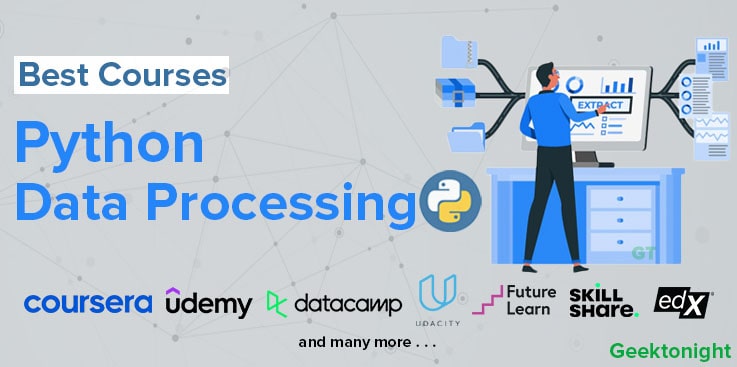Every year, trillions of data are exchanged online and millions of pieces are added each year. As per the survey, data scientists spend 80% of their time collecting, cleaning, and organizing data sets.
Data analysis takes a lot of time and so does Data Processing. It becomes tedious to handle all the data sets. So Data Analysts and machine learning experts use Python for Data Processing. In this article, we will discuss the Best Python for Data Processing Courses and certifications.
But your mind asks one of the key questions:

Why do we need Python for data processing?
Python is a simple and easy-to-understand programming language and provides toolkits for automating repetitive tasks and data visualization. LinkedIn says the demand for Python programmers has increased by 41% around the world. Learning Python can help you build the best career in data science and machine learning. Python Developers earn +8.31% more than $114,470 base salary according to Indeed.
Whether you are ready to build a career or just want to learn about data processing, the list of Best Python Data Processing Courses will help you. If you want to understand more about data analysis, check out the article on Best Python Data Analysis Courses. That could benefit you.
Table of Content
Our product recommendations are unbiased and based on an independent review process. We may receive a commission for links to recommended partners. See our advertiser disclosure for more information.
Best Python Data Processing Courses, Certification, Tutorials, Training, Classes Online
- Best for Visualization Basic Data Processing and Visualization by UC San Diego [Coursera]
- Best Budget Option Complete Data Science Training with Python [Udemy]
- Best for Chinese Data Processing with Python by Nanjing University [Coursera]
Basic Data Processing and Visualization by UC San Diego [Coursera]
This Data Processing in Python Course is the first part of the four-course specialization, that’s Python Data Products for Predictive Analytics. You will be going to learn the basics of reading and manipulating datasets in Python. You will understand what exactly a data product is, how to perform data retrieval, data processing, and data visualization. At each step, you will gain hands-on experience in data manipulation and build skills by completing a capstone project.
Course Instructor
This Basic Data Processing and Visualization Course were designed by Julian McAuley and Ilkay Altinats to introduce you to the field of Data Science. They will prepare you for the other three courses: Design Thinking and Predictive Analytics for Data Products, Meaningful Predictive Modeling, and Deploying Machine Learning Models. It is the perfect time to add this valuable skill set to your job profile.
What You’ll Learn
This Basic Data Processing using Python course is part of the Python Data Products for Predictive Analytics Specialization. It is divided into five modules which can be completed in five weeks.
- Introduction to Data Products: This module will provide materials and softwares and go through the course materials. You will learn about data products and have a chance to review Python and Jupyter notebooks.
- Reading Data in Python: In this module, you will discover how to import datasets from CSV and JSON files. With the instructors, you will practice fundamental Python commands on the large datasets.
- Data Processing in Python: This week, you will figure out ways to prepare a dataset for analysis and how to interact with various data kinds, such as dates and strings.
- Python Libraries and Toolkits: This week will get an understanding of common Python libraries and their potential applications.
- Final Project: In the final week, you will build your own Jupyter notebook to practice data manipulation, and demonstrate the abilities you’ve gained.
Pros & Cons
Pros
- Certificate on Completion
- Financial Aid Available
Cons
- Prior knowledge of programming
Key Highlights & USPs
- Learn how to develop a data strategy and process for how data will be generated, collected, and consumed.
- Refresh your memory on Python 3 fundamentals and how to work with Jupyter Notebooks.
- Discover the ways to deal with data in various formats and clean datasets by removing outliers.
- Learn to import and process formatted datasets such as CSV and JSON.
- Build data visualization with Numpy and Matplotlib.
- Understand how to do web scraping with Urllib and Beautifulsoup.
- Get a chance to practice data manipulation and create your Jupyter Notebook with a dataset.
Who is it for?
UC San Diego offered this Data visualization and Processing using Python Course for students who are keen on learning how data processing works with Python libraries. You should have prior knowledge of the Python programming language. Upon completion, you will be able to implement Python libraries for retrieval, processing, and visualizing data. If you want a clear understanding of data visualization, check the compiled list of Best Data Visualization Courses.
Rating: 4.3/5
Students Enrolled: 16,811
Duration: 11 Hours
Complete Data Science Training with Python [Udemy]
Udemy introduces you to The Complete Guide to Practical Data Science and Data Processing with Python. You will learn about Statistics, Data Analysis, and Data Science in this 12-hour whole package. This Data Science Training with Python Course will teach you how to store, filter, manage and manipulate the data in Python. You will perform data analysis and read data from different sources ( including web pages). Further down, You will clean the data to process further using powerful Python libraries. In the end, you will become proficient in dealing with collected real-life data and carry out data analytics.
Course Instructor
This Udemy Data Science Course was created by Minerva Singh that covers all the aspects of data science, statistical modeling, data visualization, and machine learning. You don’t have to waste your time searching for online courses or books on Python Data Science Course. You will go through data exploration to build deep learning models using Python. It’s quite an elaborative course for learners to check how data processing and visualizing are used for predicting the future
Pros & Cons
Pros
- Valuable and effective lectures
- Certificate on Completion
Cons
- Not well-explained topics
- Not updated recently
Key Highlights & USPs
- This Udemy Data Science Training Course includes 13 sections and 124 lectures to data analysis methods using Python.
- Learn to install Anaconda, a powerful framework for data analysis, and set up the Jupyter Notebook Environment for Python.
- Discover basic analytical tools of Python such as Numpy arrays, operations, arithmetic, Vectors, etc.
- How to use Data Structures and Pandas for reading the generated data from CSV, Excel, JSON, HTML data.
- Carry out data pre-processing and data wrangling tasks using Python.
- Implement supervised and unsupervised learning techniques on real data.
- Understand the difference between Machine learning and Statistical Data Analysis.
- Build basic neural networks and write deep learning algorithms.
Who is it for?
This beginner-level Python Data Processing Tutorial is for professionals or beginners who are equipped with python skills and want to learn data processing. Once you’ve completed this certification, you will master the art of implementing Python-based data science knowledge into real data and start analyzing data for your projects. You can use a certificate to display your expertise to potential employers with a portfolio.
Rating: 4.1/5
Students Enrolled: 8,028
Duration: 13 Hours
Data Processing with Python by Nanjing University [Coursera]
Learn data processing to power your data analysis knowledge. You may be aware that, Data processing is the method of manipulating the raw data to perform desired operations. This Data Processing with Python Program will teach you how to use the general-purpose Programming language for acquiring, analyzing, and presenting the data. You will get to conduct basic and advanced statistical analysis on the raw data. You will understand how to design a GUI to process and visualize the data. This whole data processing course is based on Financial data and provides a chance to work on case studies one after another.
Course Instructor
Zhang Li, a professor at the Nanjing University, designed this Data Processing Python Course to discuss how fast and efficient the data processing capacity of Python is. You will feel the simplicity and robustness of Python that can apply to any field.
What You’ll Learn
This Coursera Data Processing Specialization will teach fundamentals in 5 courses, namely:
- Welcome to Data Processing with Python: You will learn how to utilize Python for expressing and analyzing data using SciPy, Requests, Beautiful Soup packages, etc. in this course.
- Data Acquisition and Presentation: After completing this module, you will be able to use Python’s basics, such as sequence, string, list, and tuple to process data with ease.
- Powerful Data Structures and Python Extension Libraries: Data structure dictionaries and sets are examples of advanced-level Python. This module will help you with effective data structures as array, Series, and Dataframe.
- Python Data Statistics and Mining: This module will help you benefit from Python for data processing and analysis.
- Object Orientation and Graphical User Interface: This module will introduce object orientation and how it relates to graphical user interfaces.
Pros & Cons
Pros
- Concise and effective lectures
- Excellent instructor
- Certificate on Completion
- Financial Aid Available
Cons
- Only for Chinese students
- No English subtitles available
Key Highlights & USPs
- Learn how to use Python 3 and its powerful libraries to write programs for processing the data.
- Master the basics of Python such as data structures, conditions, loops, and functions.
- Get practical experience by acquiring the local data and network data using data structures, strings, and lists in Python.
- Gain the foundational knowledge of intermediate and advanced-level uses of Python.
- Learn to use Python Data Statistics and Data Mining methods during processing the data.
- Understand the relationship between object-oriented programming and Graphical User Interface.
Who is it for?
This Coursera Python Data Processing Course is a beginner-level training course for professionals and graduates with little Python programming experience. If you don’t know Python 3, you can check the list of Best Python Online Courses. Upon completion, you can gain skills that help you process large datasets using Python libraries and tools. While applying for your upcoming job, the certificate of completion will showcase what you’ve learned.
Rating: 4.2/5
Students Enrolled: 49,026
Duration: 29 Hours
FAQ
Is Python good for data processing?
Yes, Python is good for data processing as it has a high processing speed. Python code requires less time to compile as compared to other programming languages. Its simplicity and easy-to-manage code support various ideas while keeping transparency between code and execution.
What is data processing in Python?
Data Processing is the concept of presenting the data in different kinds of encoding formats, including CSV, XML, HTML, JSON, and SQL, etc. So every processing format is different from the other. It also takes quite a lot of time.
Here, Python comes as a supportive programming language to handle various encoding processes. Python uses Numpy and Pandas libraries to manage these processing formats.












